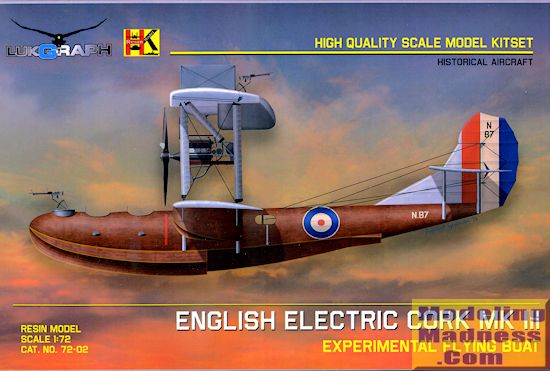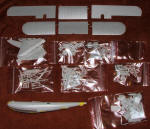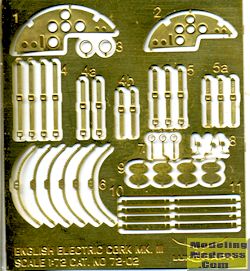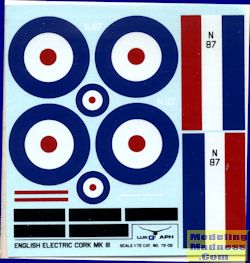
Lukgraph 1/72 English Electric Cork III
| KIT #: | 72-02 |
| PRICE: | $ |
| DECALS: | One option |
| REVIEWER: | Scott Van Aken |
| NOTES: | Resin kit with small p.e. fret |

| HISTORY |
The last significant large flying boat to appear before the Armistice was the Phoenix P.5 Cork, which first flew on 4 August, 1918. Designed to specification N.3, the Kork used a Linton Hope designed hull built by May, Harden & May. Hulls were then delivered to the Phoenix Dynamo Manufacturing Company where flying surfaces were attached and a pair of Eagle VIII engines were installed.
The first of two aircraft, N86, showed promising performance which surpassed the Felixstowe F.3 in the air and on the waer. Comparisons with the F.5 also saw the Cork I have better speed, climb rate and range. A second airframe, Cork II N87 did not fly until March 28, 1919 as the hull was modified. However, the Armistice put an end to any production orders and the aviation department of Phoenix was closed. In the meantime, the company was purchased by English Electric and with a change in engines to the Napier Lion Mk IIIB, it became the Cork III.
| THE KIT |
 This is Lukgraph's second resin kit and is very much like the previous offering. The kit is a collaborative effort between Lukgraph and HK resin. There are over 200 parts, many of them quite small. There are several things I really like about how this kit was engineered. Yes, there are a ton of very small parts, as you would expect from a large airplane of this era, but the major load bearing struts are molded around wire so they will not sag over time. Not only that, but all of the wing sections have large gauge wire molded into the parts and these slip into holes that are pre-drilled into the receiving parts of the wing sections. To make construction even more pleasant, all of the large pieces have already been removed from the pour stubs and this is true of even some of the smaller bits. The fuselage halves were taped together and like the bags for the rest of the bits, were wrapped in bubble wrap.
This is Lukgraph's second resin kit and is very much like the previous offering. The kit is a collaborative effort between Lukgraph and HK resin. There are over 200 parts, many of them quite small. There are several things I really like about how this kit was engineered. Yes, there are a ton of very small parts, as you would expect from a large airplane of this era, but the major load bearing struts are molded around wire so they will not sag over time. Not only that, but all of the wing sections have large gauge wire molded into the parts and these slip into holes that are pre-drilled into the receiving parts of the wing sections. To make construction even more pleasant, all of the large pieces have already been removed from the pour stubs and this is true of even some of the smaller bits. The fuselage halves were taped together and like the bags for the rest of the bits, were wrapped in bubble wrap.
With all those parts it is pretty much impossible to show them all, but if you visit Lukgraph's web site, he has some additional images. You would expect a kit like this to be highly reliant on photo etch for detail, bu t that is not the case. Lukgraph realizes that flat bits do not do an adequate job of representing 3D items so saves the p.e. for things like seat belts, gun bits, flat panels and the like.
t that is not the case. Lukgraph realizes that flat bits do not do an adequate job of representing 3D items so saves the p.e. for things like seat belts, gun bits, flat panels and the like.
While you would expect a 1920's biplane to be pretty simple in that it doesn't have a lot of external ordnance or antennas, there are a lot of struts and other bits in this kit. For instance, the interior has a major floor section for the pilots and the gunner. The cockpit has a pair of pilot seats, rudder pedals and control columns. There are some bits that attach to the inside of the fuselage, which also has molded in frame detailing.
A lot of parts go into doing the wings. Due to the arrangement of the engines, the wings have to be done in sections. This is where the metal rod reinforcements come in very handy. As was typical of the day, the engines are uncowled and so you get to see them in their entirety, along with various radiators and hoses. On the upper wing is another gun position, for which you have a nicely done tub. Many of the photo etch bits are specifically for the gun positions. The final assembly mates the outer wings and their corresponding struts to the fuselage. It is at this time that the lower wing float assemblies are attached. The kit includes resin clear bits for the windscreen and windows as well as full color stickers to represent instruments that go behind the etched panels.
The kit includes resin clear bits for the windscreen and windows as well as full color stickers to represent instruments that go behind the etched panels.
The instructions are very well done and in landscape format. You are provided keys to which parts are photo etch, there is color information on every page and a full rigging diagram is supplied. There are also smaller alignment diagrams throughout the build to ensure you are getting things in the proper place. Fuel and water line placement is also shown in case you wish to add that detail. Markings are provided for one of the two planes, which has the fuselage and floats in wood while the flying surfaces are in silver dope. The decals are very nicely done and should be quite thin. They also include some walk areas.
| CONCLUSIONS |
This is an outstanding resin kit in all respects. It is quite obvious that a lot of thought and planning went into this one and Lukgraph have gotten every right from the start. They have chosen an interesting subject and it seems that they are embarked on a program of bringing more kits like this to the modeler. It will not be an easy kit to build and so for that reason, it is recommended to those who have considerable experience with kits like this. The result of one's efforts in this regard will be a superlative model that will have pride of place on your display shelves.
| REFERENCES |
Kit instructions as there is very little about this plane from the usual Internet sources.
February 2015 Thanks to www.lukgraph.pl for the preview kit. Contact them via their web site for your kit. It can also be found at some very select dealers. If you would like your product reviewed fairly and fairly quickly, please contactthe editor or see other details in the